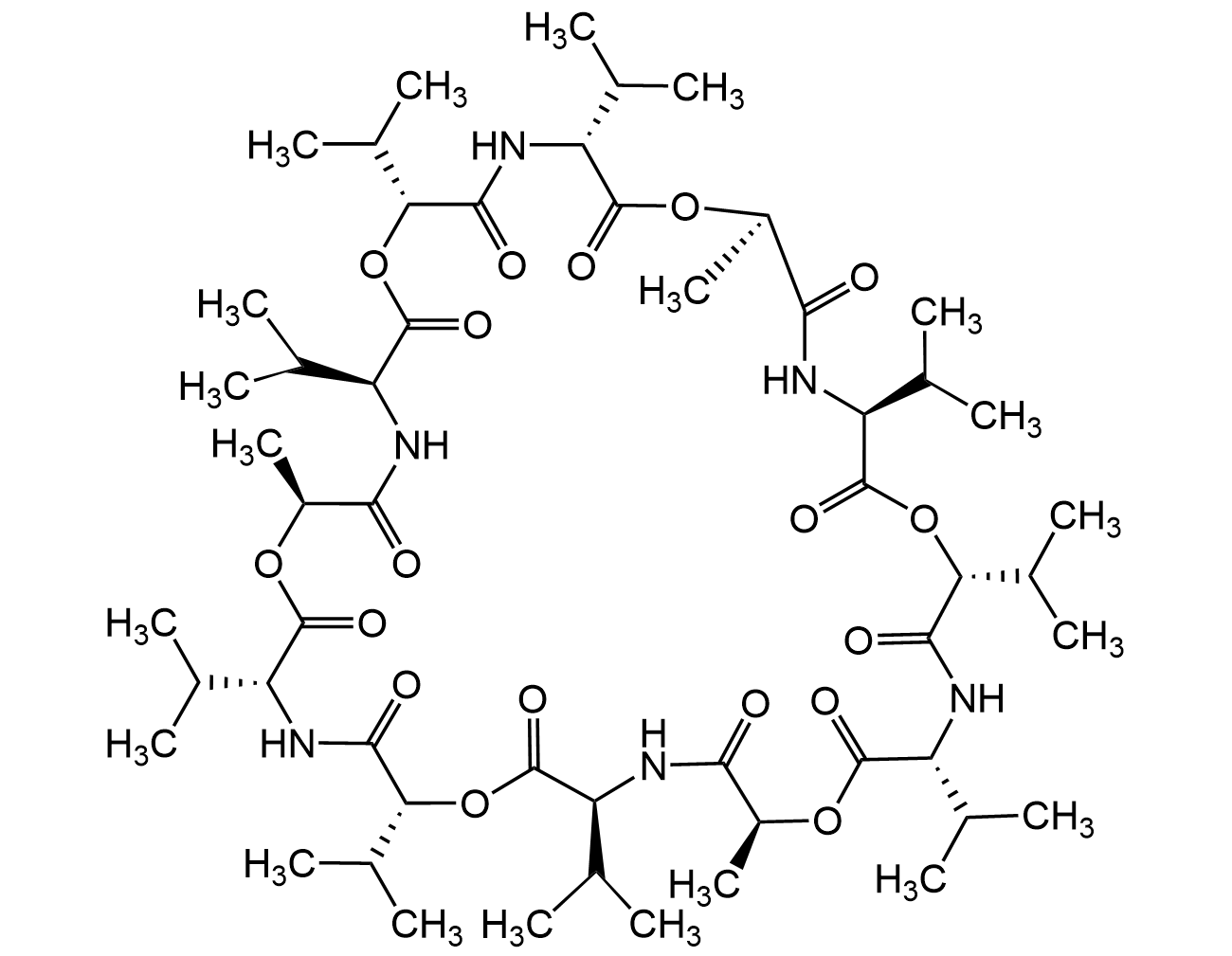Valinomycin
| Code | Size | Price |
|---|
| CDX-P0163-M025 | 25 mg | £97.00 |
Quantity:
| CDX-P0163-M100 | 100 mg | £300.00 |
Quantity:
Prices exclude any Taxes / VAT
Overview
Regulatory Status: RUO
Shipping:
Ambient
Storage:
Short term: -20°C. Long term: -20°C
Images
Documents
Further Information
Alternate Names/Synonyms:
Potassium ionophore I; Cyclo(L-Val-D-HyIva-D-Val-L-Lac-)3: HyIva = alpha-Hydroxyisovaleric acid, Lac = Lactic acid; NSC 122023
Appearance:
White to off-white powder.
CAS:
2001-95-8
EClass:
32160000
Form (Short):
solid
GHS Symbol:
GHS06
Handling Advice:
Protect from light and moisture.
Hazards:
H300 + H310
InChi:
InChi=1S/C54H90N6O18/c1-22(2)34-49(67)73-31(19)43(61)55-38(26(9)10)53(71)77-41(29(15)16)47(65)59-36(24(5)6)51(69)75-33(21)45(63)57-39(27(11)12)54(72)78-42(30(17)18)48(66)60-35(23(3)4)50(68)74-32(20)44(62)56-37(25(7)8)52(70)76-40(28(13)14)46(64)58-34/h22-42H,1-21H3,(H,55,61)(H,56,62)(H,57,63)(H,58,64)(H,59,65)(H,60,66)/t31-,32-,33-,34-,35+,36+,37-,38-,39-,40+,41+,42+/m0/s1
InChiKey:
FCFNRCROJUBPLU-UHFFFAOYSA-N
Long Description:
Chemical. CAS: 2001-95-8. Formula: C54H90N6O18. MW: 1111.32. Valinomycin is a cyclododecadepsipeptide antibiotic originially isolated from Streptomyces strains and displays antibacterial efficacy. Valinomycin a neutral ionophore that selectively transfers alkali metal ions via biological and synthetic lipid membranes. Valinomycin is widely used as a selective potassium (K+)-selective ionophore (over Na+) and is an important research tool for membrane and membrane vesicles studies. As ionophore valinomycin has found application as a biosensor to detect potassium (K+) efflux. Valinomycin induces apoptosis in several cell types, including CHO cells, by stimulating potassium efflux and leading to phosphatidylserine membrane translocation, caspase-3 activation, inducing mitochondrial damage and oxidative stress. Valinomycin shows antitumor, antifungal, antiviral, insecticidal and antibacterial effects. Valinomycin as a mitophagy activator also plays a positive role in the treatment of Parkinsons disease and Alzheimers disease. It was recently reported to have antiviral activity against several coronaviruses (FIPV, MERS-CoV, SARS-CoV, HCoV-OC43 or SARS-CoV2).
MDL:
MFCD00005114
Molecular Formula:
C54H90N6O18
Molecular Weight:
1111.32
Package Type:
Vial
PG:
I
Precautions:
P262 - P264 - P280 - P301+P310-P302+P352+P310 - P361+P364
Product Description:
Valinomycin is a cyclododecadepsipeptide antibiotic originially isolated from Streptomyces strains and displays antibacterial efficacy. Valinomycin a neutral ionophore that selectively transfers alkali metal ions via biological and synthetic lipid membranes. Valinomycin is widely used as a selective potassium (K+)-selective ionophore (over Na+) and is an important research tool for membrane and membrane vesicles studies. As ionophore valinomycin has found application as a biosensor to detect potassium (K+) efflux. Valinomycin induces apoptosis in several cell types, including CHO cells, by stimulating potassium efflux and leading to phosphatidylserine membrane translocation, caspase-3 activation, inducing mitochondrial damage and oxidative stress. Valinomycin shows antitumor, antifungal, antiviral, insecticidal and antibacterial effects. Valinomycin as a mitophagy activator also plays a positive role in the treatment of Parkinsons disease and Alzheimers disease. It was recently reported to have antiviral activity against several coronaviruses (FIPV, MERS-CoV, SARS-CoV, HCoV-OC43 or SARS-CoV2).
Purity:
>95% (HPLC)
Signal Word:
Danger
SMILES:
CC(C)[C@@H]1NC(=O)[C@H](C)OC(=O)[C@@H](NC(=O)[C@H](OC(=O)[C@@H](NC(=O)[C@H](C)OC(=O)[C@H](NC(=O)[C@H](OC(=O)[C@@H](NC(=O)[C@H](C)OC(=O)[C@H](NC(=O)[C@H](OC1=O)C(C)C)C(C)C)C(C)C)C(C)C)C(C)C)C(C)C)C(C)C)C(C)C
Solubility Chemicals:
Soluble in DMSO (20mg/ml) or ethanol (20mg/ml). Insoluble in water.
Source / Host:
Microbial
Transportation:
Excepted Quantity
UN Nummer:
UN2811
UNSPSC Number:
12352200
Use & Stability:
Stable for at least 2 years after receipt when stored at -20°C.
References
(1) L.A. Pioda, et al.; Clin. Chim. Acta 29, 289 (1970) | (2) I.J. Furlong, et al.; Cell Death Differ. 5, 214 (1998) | (3) R. Abdalah, et al.; Neurosci. Lett. 405, 68 (2006) | (4) L. Rose & A.T.A. Jenkins; Bioelectrochem. 70, 387 (2007) | (5) M.A. Kroten, et al.; Pol. J. Microbiol. 59, 3 (2010) | (6) B. Klein, et al.; Apoptosis 16, 1101 (2011) | (7) K.-S. Chang, et al.; Biosens. Bioelectronics 31, 137 (2011) | (8) X. Xiong, et al.; Exp. Cell Res. 396, 112266 (2020) | (9) D. Zhang, et al.; Biomed. J. 43, 414 (2020) (Review) | (10) S. Huang, et al.; Microorganisms 9, 780 (2021) (Review) | (11) K. Gurukkalot & V. Rajendran; Curr. Microbiol. 80, 273 (2023) (Review)



